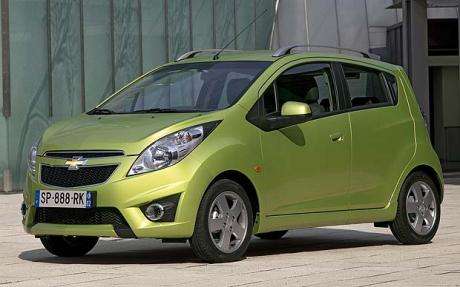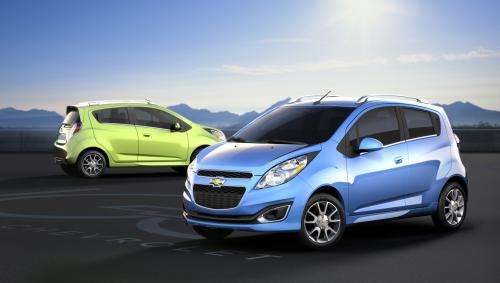Around this time next year, General Motors will unveil its first all-electric car since the EV-1. It's a battery version of the Spark mini-car that's hitting the showrooms now. In both gas and electric versions, the Spark is something of a pioneer. GM has never sold tiny A-Class vehicles in the American market, and it's never before gone mainstream with an electric - the EV1 never made it out of California and Arizona.
To say that many questions remain about the Spark EV is putting it mildly. To begin with, GM rushed out its announcement of the car late on a Friday afternoon, as if it wanted to minimize press coverage. GM damped down expectations as much as it could: "It will be sold in limited quantities in select U.S. and global markets starting in 2013, including California," the company said. You can almost feel the energy draining out of that.
The speculation was that GM is planning a "compliance car" designed to meet California's zero-emission requirements, and not a serious contender like the Volt. But what if the Spark, instead of being a "we've got one too" electric, was instead a rule breaker and barrier smasher?
The Spark, as announced last October, was to have "an advanced nanophosphate lithium-ion battery pack" from A123 Systems. There hasn't been any change in that, but A123 has had some well-publicized problems. The company is being bailed out in a $450 million deal that will see Chinese auto giant Wanxiang owning part of the battery producer. That deal has been decried by some in Congress (including Representative Cliff Stearns of Florida) because A123 received $249 million in Department of Energy stimulus funding.
In a way, that government funding was more trouble than it was worth for A123, because it was used to build a spanking-new factory in Livonia, Michigan that added huge capacity before the automakers were ready to absorb it. A123 supplies Fisker, and that company's delays in getting to market (and a subsequent battery recall) has proved crippling to A123. According to the New York Times, "Executives of A123...say the company has gotten off to a slower start than anticipated because the market for electric cars has failed to grow. The company reported a loss of $125 million in the first quarter of this year, as revenues dropped 40 percent from the year earlier."
A123 points to a recent breakthrough with batteries that can work in a wide range of temperatures without the need for external cooling or heating. But is GM getting antsy?
Earlier this month, GM CEO Dan Akerson said a few things about EV batteries that got everybody's attention. Not that many people noticed when GM Ventures, the company's investment arm, put $7 million into a battery company called Envia Systems. That company's CEO, Atul Kapadia, had been claiming major breakthroughs in range, cost and energy density. But you expect CEOs to say things like that.
Now GM's boss was confirming it. According to Akerson, "I think we've got better than a 50-50 chance to develop a car that will go to 200 miles on a charge (with Envia batteries). That would be a game changer....These little companies come out of nowhere, and they surprise you."
Go to Envia's website and the claims are bigger than that: The California-based company is talking blithely about $20,000 battery electric cars that can travel 300 (not 200) miles on a charge. If true, that's more than a game changer, it's almost game over for gas cars.
And it's not only GM that's talking about Envia. Eric Toone, the acting head of Department of Energy tech funder ARPA-E, told me earlier this month, "Envia definitely has had a battery breakthrough. And they're far along. The batteries have to be tested and deployed, and there is still a great amount of work to do, but they've moved beyond the bench scale."
So it's possible to speculate-without any actual evidence-that GM might change horses in mid-stream and install the Envia batteries it is without-a-shadow-of-a-doubt testing into the Spark. I posed just that question to Jim Federico, whose global small car realm covers all versions of the Spark.
I asked Federico about Envia, and there was a pregnant silence. "All I can tell you," Federico said eventually, "is that we have good relationships with all our suppliers, and are continuing to work with them. A123, Envia, LG, we're working with all of them."
Indeed, Kapadia told me that his company is "working with every single OEM of importance around the world. And the only thing that matters is what our customers say." He added that Envia had reached the important target of batteries (left) with 400 watt-hours per kilogram, "which wasn't easy to achieve." That milestone was confirmed in testing at the Indiana-based Naval Warfare Surface Center, which evaluates military systems.
But Kapadia also said that Envia has "nothing to announce" in the wake of Akerson's statement, and the company later got back to me with a statement.
In the prepared remarks, Kapadia said, "We are aware of the comments that were reported regarding Envia and a relationship with GM beyond GM's investment in Envia. It should not come as a surprise that Envia's world-record 400 watt-hours per kilogram technology is being sought after by automotive companies around the world. However, Envia has not yet made final decisions regarding business arrangements and there is nothing to announce at this time. Even though Envia is a participant in the fast-growing battery market, as is evident from contemporary examples, it is difficult to build a profitable battery company without leap-forward technology and a robust business model. Envia is still an exciting young company with laser-like focus on its technology and engineering."
Obviously, Envia doesn't want anybody leaping to conclusions about its partners. It wants to keep its options open. The Spark is still slated to have A123 batteries, and don't count that company out. But a deepening relationship between GM and Envia Systems may be in the offing.
More information:
©2012 Mother Nature Network
Distributed by MCT Information Services






















